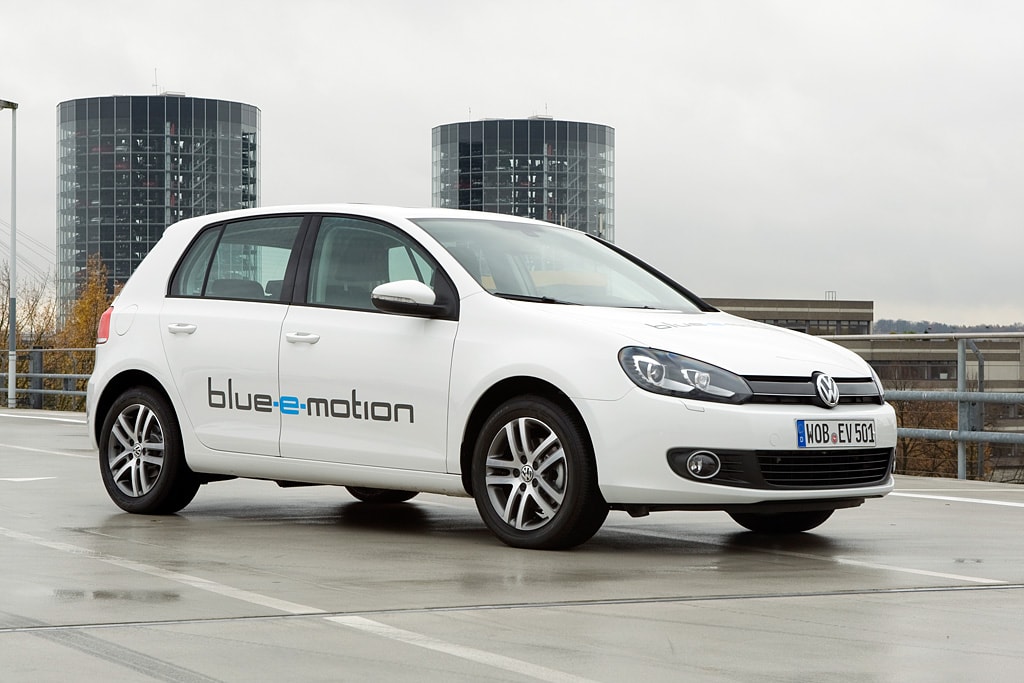With the Golf blue-e-motion – the all electric version of the most successful European car ever built – Volkswagen is preparing its entrance in the new era of transportation. After more than three decades of research for a zero-emissions future, and numerous attempts to deliver a clean transportation solution, Volkswagen is proudly presenting its concept that will probably hit the market in 2014.
The electric motor situated in the engine compartment at the front of the car delivers a maximum power of 85 kW / 115 hp and a continuous power output of 50 kW / 68 hp. Like all electric motors, the one in the Golf delivers a very high maximum torque (270 Nm or 200 lb-ft) available at 0 rpm.
The electricity for powering the electric motor is stored in a lithium-ion battery with a capacity of 26.5 kilowatt-hours. Depending on the driving style and other factors such as the use of air conditioning or heater, the Golf can attain a range of up to 150 kilometers (93 miles). The final driving range of the production model is expected to be significantly improved with the battery technology used at the production launch.
More noticeably than on petrol or diesel engines, the maximum range of an electric car is dramatically reduced when its maximum power is demanded frequently. Engineers at Volkswagen enhanced the Golf's aerodynamic profile so that friction causes the least amount of energy loss when traveling at a higher speeds. The car makes use of its kinetic energy to recharge the battery when not accelerating. The car's dynamic qualities are underlined by its short 0 to 100 km/h (62 mph) time of 11.8 seconds.
The driver has a selection of three profiles to choose from, which control the engine's maximum power and battery regeneration settings. In the "Comfort+" profile, the full 85 kW of power is available, which can propel the car to the specified top speed of 135 km/h (83 mph). In the "Normal" profile, the power is limited to 65 kW and top speed is lowered to 115 km/h (71 mph). In the "Range+ " mode, the engine controller limits the power to 50 kW and the car can reach a top speed of 105 km/h (65 mph).
There are four brake settings (D to D3) that control the energy recovery strategy. In the lowest stage (D) the car "sails" as soon as the driver lifts his foot off the accelerator. In the D3 stage, the maximum amount of kinetic energy is recovered and fed to the battery.
The Golf can be charged via a plug connector hidden behind the VW logo on the front grille. Details of the charge level are continually updated in the multifunction display.
Despite the fact that electric car batteries are known to be heavy, the car weighs just 205 kg (452 lbs) more than a comparable Golf BlueMotion TDI with DSG.
The electric motor situated in the engine compartment at the front of the car delivers a maximum power of 85 kW / 115 hp and a continuous power output of 50 kW / 68 hp. Like all electric motors, the one in the Golf delivers a very high maximum torque (270 Nm or 200 lb-ft) available at 0 rpm.
The electricity for powering the electric motor is stored in a lithium-ion battery with a capacity of 26.5 kilowatt-hours. Depending on the driving style and other factors such as the use of air conditioning or heater, the Golf can attain a range of up to 150 kilometers (93 miles). The final driving range of the production model is expected to be significantly improved with the battery technology used at the production launch.
More noticeably than on petrol or diesel engines, the maximum range of an electric car is dramatically reduced when its maximum power is demanded frequently. Engineers at Volkswagen enhanced the Golf's aerodynamic profile so that friction causes the least amount of energy loss when traveling at a higher speeds. The car makes use of its kinetic energy to recharge the battery when not accelerating. The car's dynamic qualities are underlined by its short 0 to 100 km/h (62 mph) time of 11.8 seconds.
The driver has a selection of three profiles to choose from, which control the engine's maximum power and battery regeneration settings. In the "Comfort+" profile, the full 85 kW of power is available, which can propel the car to the specified top speed of 135 km/h (83 mph). In the "Normal" profile, the power is limited to 65 kW and top speed is lowered to 115 km/h (71 mph). In the "Range+ " mode, the engine controller limits the power to 50 kW and the car can reach a top speed of 105 km/h (65 mph).
There are four brake settings (D to D3) that control the energy recovery strategy. In the lowest stage (D) the car "sails" as soon as the driver lifts his foot off the accelerator. In the D3 stage, the maximum amount of kinetic energy is recovered and fed to the battery.
The Golf can be charged via a plug connector hidden behind the VW logo on the front grille. Details of the charge level are continually updated in the multifunction display.
Despite the fact that electric car batteries are known to be heavy, the car weighs just 205 kg (452 lbs) more than a comparable Golf BlueMotion TDI with DSG.
